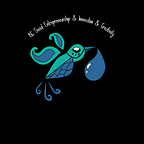Robert College SDG 13 Climate Action Challenge Workshop 1 — Empathy
Authors: İpek (Grade 9), Soykan (Grade 10), Aslı (Grade 10)
Editor: Barış (Grade 12)
RC Social Entrepreneurship, Innovation, and Creativity Office organized the first design thinking workshop on empathy with SDG 13 Climate Action Challenge Teams. Four selected teams got together to learn about what they will be doing during this 8-month challenge, while sharing their insights to co-create.
A Safe Space For Everyone
Teams started by establishing their community values, through which they can create a safe and enjoyable sharing circle. Each team came up with their core values, stated potential problems and corresponding solutions they might encounter during the journey. They co-created a community contract guiding the community in the next 6 months.
The Main Question: WHY?
We moved on to watching a thought-provoking TED Talk by Simon Sinek: Golden Circle. While inviting the audience to reflect on how leaders and companies become influential, Simon Sinek suggests to think, act and communicate. He introduced us to the methodology of “The Golden Circle”:
- Why: Every organization needs to start with, define, and share their purpose.
- How: Organizations need to have their unique approach on how to do something.
- What: Organizations need to know what they produce and the purpose of production.
We learned that members care more about the beliefs of a movement than their final product. Hence, we asked our teams to design videos on their team “Why”s for participating in SDG 13 Challenge.
What is design thinking?
SDG 13 teams will use design thinking as a framework to respond to the climate crisis. We can’t think of a better way to get our participants to familiarize themselves with all of the stages of design thinking other than starting with a mini challenge to create a wearable technology. The teams were asked to choose one of their members as a real life customer, interview them to understand their needs and to design a piece of wearable technology that would make their life better. Teams prototyped their designs, asked their customers for feedback, and configured their designs accordingly. Later on, the teams shared their ideas with the main group.
The ideas included:
- a smart backpack that would prevent carrying heavy load and theft
- a shoe that would change colors by converting kinetic energy to heat
- a sensor for visually impaired people to put over their fingers that would turn the Braille alphabet to sound
- glasses that would prevent fogging
- a smart watch with specialized features for preventing the spread of Covid-19
The First Stage of Design Thinking: Empathy!
The first workshop focused on the first stage of Design Thinking: Empathy. This stage allows us to set aside our pre-existing assumptions about the world and to gain insights about the users and their practical needs.
To take their ideas to the next step, to enrich their plans, and to amplify their projects, teams were introduced to 6 Human Centered Design tools from IDEO:
We are very excited to co-create with our teams and inspire each other during our 8-month journey. Please share your comments, insights, and questions with us.
What is your takeaway from this post? We’d love to hear your ideas.
